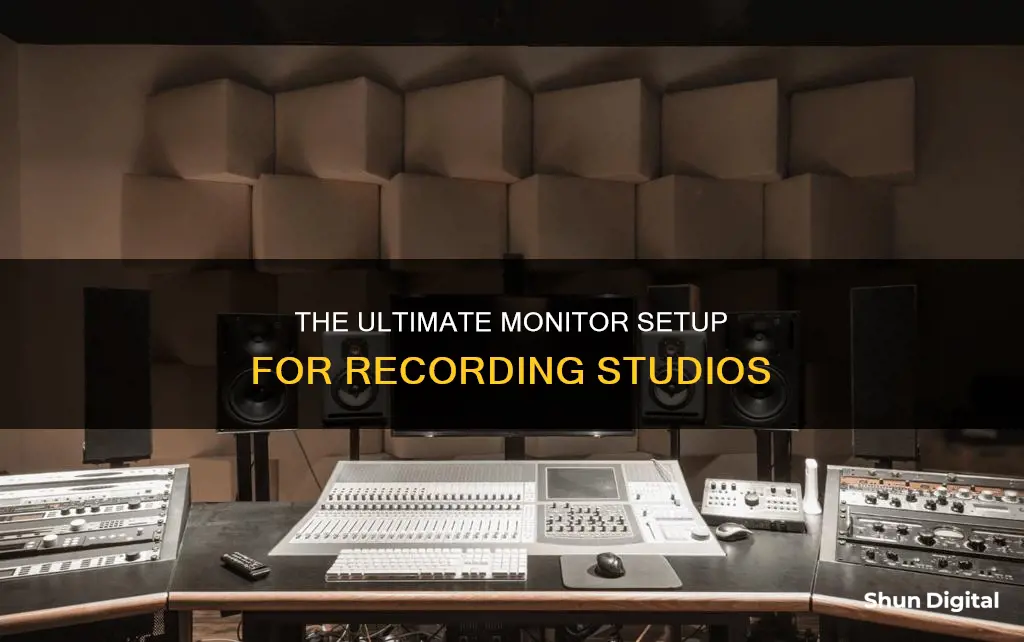
Studio monitors are an essential component of any recording studio, providing an accurate and neutral sound for mixing and mastering audio tracks. While the number of monitors can vary, most studios typically use a pair of monitors to achieve a good stereo sound. The placement of these monitors is crucial, forming an equilateral triangle with the listener's head for the most accurate frequency response and stereo imaging. In addition to the main monitors, some studios employ multiple sets of monitors to cater to different listening experiences, such as three-way and two-way speakers. Larger monitors are also useful for impressing clients and accommodating a room full of people. The size of the monitors depends on the studio size, with smaller monitors suited for home studios and larger monitors for semi-professional or commercial studios. Active monitors, with built-in amplifiers, are more common and convenient, while passive monitors offer flexibility with external amplifiers. Ultimately, the choice between one or multiple sets of monitors depends on the specific needs and preferences of the user, as well as the studio space and intended listening experience.
| Characteristics | Values |
|---|---|
| Number of Monitors | A single pair of monitors is fine, but some studios have multiple sets of monitors. |
| Monitor Type | 2-way or 3-way. 2-way is enough to mix dance music, but for complex movie soundtracks, a 3-way monitor is more suitable. |
| Speaker Size | Small (4-6 inches) for small home studios, large (6-10 inches) for semi-professional studios. |
| Active or Passive | Active monitors are more common, but some engineers prefer passive monitors. |
| Near-field or Far-field | Near-field monitors are designed to be used within a few feet of the listener, while far-field monitors are designed to provide accurate sound across an entire room. |
What You'll Learn
- Studio monitors are speakers used to mix and master music
- Active monitors have built-in amplifiers, while passive monitors require external amplifiers
- Speaker placement is critical for optimal sound
- The size of the woofer determines the range and clarity of bass and lower midrange frequencies
- Subwoofers are useful for standard stereo mixing and surround sound media production

Studio monitors are speakers used to mix and master music
Studio monitors are typically placed on stands or a mixing console, with the listener seated a few feet away, and the speakers positioned at ear height. This setup allows the engineer to hear the audio in a relatively neutral listening environment. The placement and listening position are crucial for accuracy, as the sound can be distorted if the speakers are not directed towards the listener's ears.
Studio monitors can be active or passive. Active monitors have built-in amplifiers, making them simpler to use and set up. Passive monitors, on the other hand, require external amplifiers and offer more flexibility.
The number of studio monitors needed depends on the specific requirements of the studio. A single pair is usually sufficient, but some studios use multiple sets of monitors to cater to different listening experiences and environments. For example, a pair of three-way monitors may be the primary set, with a smaller set of two-way speakers as an additional reference for how most people listen to music on headphones or speakers. Larger monitors are also useful for impressing clients and filling a room with sound.
In summary, studio monitors are designed to provide an accurate and flat frequency response, making them essential tools for mixing and mastering music in recording studios. The placement, type, and number of monitors depend on the specific needs and preferences of the engineer and the studio setup.
Monitoring Data Usage: A Guide to Tracking Globe-wide
You may want to see also

Active monitors have built-in amplifiers, while passive monitors require external amplifiers
When setting up a recording studio, one of the most important decisions you'll make is choosing the right type of monitors. Active monitors and passive monitors are the two main types available, and understanding their differences is crucial for achieving optimal sound quality.
Active monitors, also known as powered studio monitors, have built-in amplifiers, offering a streamlined setup. This integration simplifies the cabling process and enhances synergy between the amplifier and speakers, resulting in optimal performance. The built-in amplifiers are specifically designed for and tuned to the monitors, often resulting in superior sound quality. Active monitors are generally more expensive upfront due to the built-in amplifiers, but they offer a convenient "all-in-one" solution and can be more cost-effective in the long run as no additional equipment is required.
On the other hand, passive monitors require external power amplifiers, providing users with more flexibility and customization options. With passive monitors, you have the freedom to select and upgrade the external amplifier to fine-tune your sound system. This tailored approach allows you to tweak your setup to perfection and customize your configuration with separate components. However, passive monitors can be more complex to set up and may require more space due to the additional equipment. They are typically less expensive upfront but may end up costing more in the long run due to the need for separate amplifiers.
When deciding between active and passive monitors for your recording studio, consider factors such as budget, space constraints, and your preference for customizability. Active monitors provide a simpler, plug-and-play solution with reliable sound quality, while passive monitors offer the flexibility to pair different amplifiers and speakers to meet your specific needs.
Connecting Apple TV to a Monitor: A Simple Guide
You may want to see also

Speaker placement is critical for optimal sound
Speaker placement is critical for achieving optimal sound in a recording studio. The positioning of monitors can significantly impact the accuracy and quality of sound reproduction, and there are several factors to consider for optimal speaker placement.
Firstly, it is important to achieve symmetry in the room. Placing monitors along the short wall of the room can help reduce sonic reflections and improve sound accuracy. This setup yields better results, especially in smaller spaces. Centering the speakers on a single wall is preferable to setting them up in the corner of a rectangular room.
Secondly, the height of the monitors is crucial. They should be positioned at ear level, with the tweeters of the speakers at head height, allowing the listener to be directly in front of the speakers. This setup ensures the most consistent and optimal sound, as the directional pattern of sound from the speaker varies as one moves from the front and center. If the speaker stands or console are too low, speaker stands can be used to elevate them to the appropriate height.
Thirdly, reflections from nearby hard surfaces should be minimised. Acoustically hard surfaces, such as windows, drywall, mirrors, and non-absorptive materials, can reflect sound and alter the original sound output. Placing absorption materials on reflective surfaces can help reduce this issue.
Additionally, the distance between the speakers and the listener is important. An equilateral triangle should be formed, with the listener at the apex of the triangle, ensuring that the tweeters of the speakers are pointed directly at the listener's ears. This setup enhances accurate stereo imaging and provides a strong centre image.
Lastly, the proximity of speakers to walls, especially sidewalls, can affect the bass response. Moving speakers closer to walls and corners increases bass output, while pulling them away reduces bass intensity. The "rule of thirds" suggests that the ideal distance between speakers and the wall behind them should be one-third of the room's length for optimal bass response.
By carefully considering these factors and making adjustments, one can achieve optimal sound in a recording studio and significantly improve the overall listening experience.
Monitoring Plex CPU Usage: A Comprehensive Guide
You may want to see also

The size of the woofer determines the range and clarity of bass and lower midrange frequencies
The woofer is an essential component of a stereo system, playing frequencies below the range of a tweeter and just above what subwoofers can reproduce. The size of the woofer determines the range and clarity of bass and lower midrange frequencies.
A woofer's size typically ranges from 2-3 inches up to 8-10 inches. This larger size, compared to a tweeter, gives woofers more excursion capability, allowing them to move more air and reproduce lower frequencies with greater accuracy. The name "woofer" comes from the idea that dogs bark or "woof" in low frequencies.
In a stereo system, a woofer will play frequencies from around 2,000-5,000 Hz down to 50-100 Hz. This range captures the lower midrange frequencies, which are extremely important for shaping the character of sound. It includes the fundamental frequencies of many acoustic instruments, such as brass instruments and woodwinds like the alto saxophone and clarinet.
The lower midrange frequencies also include the low-order harmonics of most instruments, adding richness and complexity to their tonal profiles. Boosting around 300 Hz can enhance clarity in bass and lower-stringed instruments, while excessive boosting around 500 Hz can muffle higher-frequency instruments.
When it comes to studio monitors, the size of the woofer is an important consideration. For home studios, 5-inch woofers are often a good choice as they are well-suited to the limited space. However, the size of the woofer should also be aligned with the style of music being produced. For example, if you are producing EDM, you will need a better low-frequency response, so a bigger woofer size is recommended. On the other hand, smaller woofers may offer better midrange and high-frequency response due to their ability to reproduce these frequencies more accurately.
Application Performance Monitoring: Ensuring Software Quality and User Satisfaction
You may want to see also

Subwoofers are useful for standard stereo mixing and surround sound media production
When it comes to studio monitors, there are a few things to consider. Firstly, the size of the room and the type of music being produced will dictate the number and size of monitors needed. For example, if you are producing EDM, you will require a better low-frequency response and a bigger driver size. Additionally, having multiple sets of monitors can be useful for referencing and comparing mixes.
Now, onto the topic of subwoofers. Subwoofers are indeed useful for standard stereo mixing and surround sound media production. They are designed to reproduce low frequencies, typically in the range of 20Hz to 80Hz. In a stereo setup, a subwoofer can be added to a pair of studio monitors, creating a 2.1 system. This extends the low-frequency range and allows the monitors to produce midrange frequencies more efficiently.
In a surround sound setup, a subwoofer is required to handle the low-frequency effects (LFE) channel. This is often denoted as 5.1, indicating five main channels plus the subwoofer. The subwoofer in this case also handles the bass content of all five main channels, allowing for the use of smaller satellite speakers.
It's important to note that a subwoofer should be chosen based on the room's acoustics. Poor room acoustics can negatively impact the performance of a subwoofer, and it may be necessary to treat the room with acoustic panels, diffusers, or bass traps to improve the sound.
When setting up a subwoofer, proper placement and alignment are crucial. The subwoofer should be located at the same distance from the listener as the satellite speakers, ideally in front of the listener. The crossover frequency between the satellite speakers and the subwoofer should be set below 90Hz to ensure the subwoofer remains undetectable.
In summary, subwoofers are an essential component of a recording studio setup, providing accurate and extended low-frequency reproduction for both stereo and surround sound applications. When chosen and configured correctly, they can greatly enhance the mixing and listening experience.
Monitor Broadband Usage: A Guide for BSNL Users
You may want to see also
Frequently asked questions
Studio monitors are specifically designed for use in recording studios, radio stations, and other professional audio environments. They have a flat frequency response, meaning all frequencies are played at the same volume level, ensuring accurate mixing and mastering. Regular speakers, on the other hand, are often biased to emphasize certain frequencies, such as adding more bass.
Studio monitors can be active or passive. Active monitors have built-in amplifiers and are simpler to use, while passive monitors require external amplifiers and offer more flexibility. Studio monitors can also be 2-way or 3-way. A 2-way monitor has a tweeter for treble and a woofer for mid and low ranges, while a 3-way monitor adds a third speaker for midrange frequencies, offering enhanced clarity.
The size of the studio monitor depends on the size of your room and the type of music you produce. Smaller monitors are typically used in home studios or for producing dance music, while larger monitors are used in semi-professional or commercial studios and for genres that require more low-frequency response, such as EDM.
Most studio monitors are sold individually, but some are sold in pairs. You will need at least two monitors to achieve a good stereo sound. Some studios use multiple sets of monitors to check mixes and simulate different listening environments, but a single pair is usually sufficient for primary monitoring needs.
The ideal setup for studio monitors is to form an equilateral triangle with your head when seated in the mix position. This ensures the most accurate frequency response and stereo image. Use speaker stands if necessary to achieve the optimal height and distance from walls.







